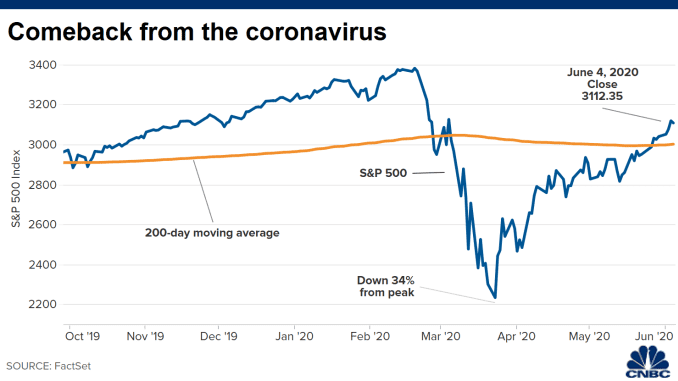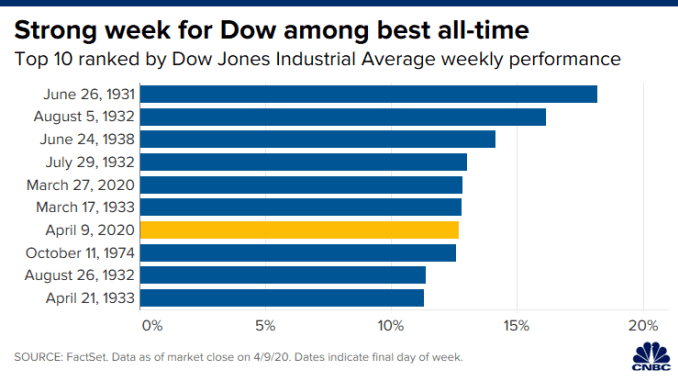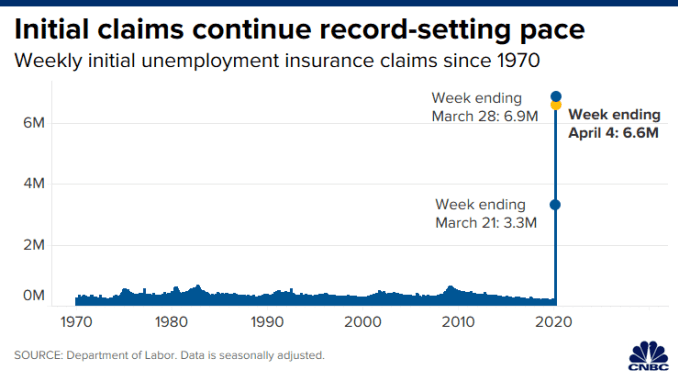
The stock market’s rapid plunge into a bear market this year has been nearly matched by a blistering rally off its lows.
Through Thursday’s close, the S&P 500 has rallied nearly 25% from a low reached on March 23. The broader market average has also retraced half of its initial drop from its record high. The Dow Jones Industrial Average is up more than 28% from its late-March low while the Nasdaq Composite has jumped 19.1% in that time.
The market’s comeback has been fueled mainly by three factors:
- An improving outlook on the coronavirus outbreak
- Massive monetary and fiscal stimulus
- Stabilizing oil prices

“As we’ve seen some hope that the coronavirus crisis may be peaking and unwavering Fed support, investor sentiment has turned,” said Lindsey Bell, chief investment strategist at Ally Invest, in a note. “This latest move up has been a welcome form of market volatility. But the world is moving fast. We believe the markets may need to get through the obstacles ahead before this bear truly ends.”
This past week, the Dow had its seventh-best weekly performance ever while the S&P 500 posted its biggest one-week gain since 1974. The Dow’s fifth best week ever was on March 27, showing the historic nature of this comeback.

Virus outlook improving
Dr. Anthony Fauci, director of the National Institute of Allergy and Infectious Diseases, said Thursday the U.S. death toll from the coronavirus “looks more like 60,000.” That’s well below the Trump administration’s initial estimates, which ranged from around 100,000 to more than 200,000 deaths. Fauci added antibody tests for the coronavirus have been developed and will be available “very soon.”
The pace of new coronavirus cases around the world is also slowing. Data compiled by Johns Hopkins University shows daily increases have fallen to a range between 73,000 and 85,000 after spiking to more than 100,000 earlier this month.
In the U.S., daily virus increases appear to have peaked around 33,000 while the hospitalization rate in New York — the state with the most confirmed cases — has fallen.
“The virus appears to be starting to slow, and the market is liking that,” said Mike Katz, partner at Seven Points Capital. “Now the question is going to be how quickly people end up going back to work.”
Stocks have also gotten a boost as the government embarks on a massive stimulus campaign to curb the economic blow from the virus outbreak.
Big government intervention
The Federal Reserve released on Thursday details on a group of programs aimed at supporting the economy. Those programs, which total up to $2.3 trillion, include loans for small and medium-sized businesses along with the purchase of investment grade and junk bonds. That announcement came after the Fed slashed rates to zero in March and launched an open-ended quantitative easing program.
Congress and the Trump administration have also allocated trillions in fiscal aid.
On March 27, President Donald Trump signed a $2 trillion stimulus package that includes direct payments for Americans of up to $1,200. The bill also provides loans for businesses to deter them from laying off employees and strengthens unemployment insurance.
“Governments are taking action with large-scale and targeted fiscal stimulus, while central banks have broken their taboos on balance sheet expansion and asset purchases,” wrote Alberto Gallo, head of macro strategies at Algebris Investments, in a note.
Stabilizing oil prices have also helped equities as they eased concerns over a massive wave of defaults within the energy sector.
West Texas Intermediate futures have rallied nearly 25% since hitting their 2020 low on March 30. However, oil prices are still down more than 60% for the year.
Sell-off laggards leading the rally
Casino and energy stocks are among the best performers since the rally off the lows began, after leading the market on its way down.
MGM Resorts is up 59% since March 23 while Wynn Resorts has rallied over 22%. The S&P 500 energy sector, which got clobbered as crude prices plunged, has jumped over 43% since the broader market bounced.
Apache, Diamondback Energy and Occidental Petroleum led the energy sector higher since then. Shares of Apache are up more than 90% since March 23 while Diamondback Energy is up 71.1% in that time period. Occidental Petroleum has rallied 58.5% since then.
Bank stocks are also among the market leaders amid the recent surge. Bank of America, for example, has rallied 37.5% since late March while JPMorgan Chase is up 30%. Citigroup and Wells Fargo are up 34% and 31.5% in that time period. Overall, the S&P 500 financials sector has gained more than 33% since late March.
Energy and financials have lagged the broader market in recent years while high-flying tech stocks such as Facebook, Amazon and Apple led the way. But Andrew Slimmon, managing director at Morgan Stanley Investment Management, said a rotation into these multi-year laggards is currently taking place.
“The leadership rotation is a very good sign for the market overall,” Slimmon said. “You don’t get leadership rotation unless it’s a sign the market is starting to think about the recovery.”
“I’m not saying it’s going straight up from here, but it’s a very good sign,” he added.
To be sure, the major averages are still well below the record highs they set in February. They could also fall back under pressure as more data shows the virus’ economic damage is greater than feared and if the virus outlook worsens once again.
Remain cautious
Market players are urging investors to stay on their toes.
“What’s happening is the markets trading on speculation of bending the curve. And that’s fine,” said Phil Blancato, CEO of Ladenburg Thalmann Asset Management. However, “the GDP numbers are going to get profoundly bad.”
“The overall earnings picture is going to be pretty tough,” Blancato added.
Wall Street has already had a glimpse of the massive economic shock the coronavirus outbreak is having.
The U.S. has lost more than 16 million jobs over the past three weeks through April 4, according to weekly jobless claims data from the Labor Department. That’s roughly 10% of the overall U.S. labor force. The number of people who filed for unemployment benefits the week of April 4 totaled more than 6 million, tying a record set the previous week.

A slew of companies have also removed their earnings guidance, citing the coronavirus outbreak, while others have slashed their profit forecasts. The corporate earnings season starts on Tuesday, with JPMorgan Chase and Wells Fargo among the companies slated to report.
Meanwhile, investors are still grappling with wild market swings on a daily basis.
The S&P 500 has posted a daily move of at least 1.5% in six of the seven trading days in April. Since the March 23 low, the broader market average has moved more than 1% in 12 of 13 trading sessions.

“You’re seeing moves that would normally take days now happen in minutes,” said Katz of Seven Points. “With that comes lots of risks, but also lots of opportunity as well.”
Katz added that the market has been able to rally despite the recently dismal economic data, noting “it was a good sign” showing the selling was overdone.
Subscribe to CNBC PRO for exclusive insights and analysis, and live business day programming from around the world.

























